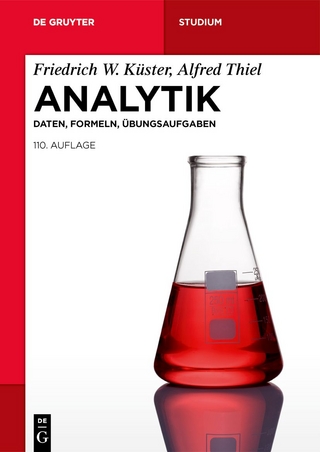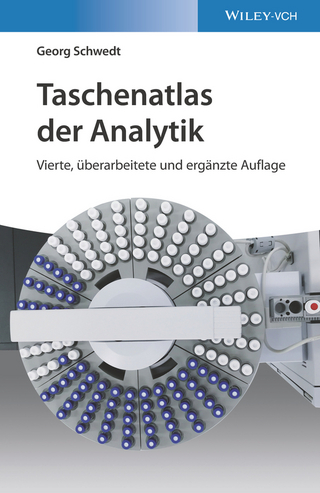
CRC Handbook of Basic Tables for Chemical Analysis, Second Edition
Crc Press Inc (Verlag)
978-0-8493-1573-2 (ISBN)
- Titel erscheint in neuer Auflage
- Artikel merken
If you are a researcher in organic chemistry, chemical engineering, pharmaceutical science, forensics, or environmental science, you make routine use of chemical analysis. And like its best-selling predecessor was, the Handbook of Basic Tables for Chemical Analysis, Second Edition is your one-stop source for the information needed to design chemical analyses.
Here's what is new in the Second Edition:
New chapters on solutions, electroanalytical methods, electrophoresis, and laboratory safety
An expanded section on gas chromatography that includes data on compounds that attack common detectors
New information on detector optimization
An updated section on high performance liquid chromatography that provides the most recent chiral stationary phases, detector information, and revised solvent tables
Updated information on the most useful "wet" chemistry methods
Enlarged section of Miscellaneous Tables
Going far beyond the landmark first edition in terms of scope and applications, the second edition provides current and updated data culled from a wide range of resources and consolidated into a concise yet easy-to-use format. The book's laser-like focus on core information gives you the knowledge you need when you need it - at the decision point.
GAS CHROMATOGRAPHY
Carrier Gas Properties
New! Carrier Gas Viscosity
Gas Chromatographic Support Materials for Packed Columns
Mesh Sizes and Particle Diameters
Packed Column Support Modifiers
Properties of Chromatographic Column Materials
Properties of Some Liquid Phases for Packed Columns
Stationary Phases for Packed Column Gas Chromatography
Adsorbents for Gas-Solid Chromatography
Porous Polymer Phases
Silicone Liquid Phases
Mesogenic Stationary Phases
Trapping Sorbents
New! Sorbents for the Separation of Volatile Inorganic Species
New! Activated Carbon as a Trapping Sorbent for Trace Metals
New! Reagent Impregnated Resins as Trapping Sorbents for Trace Minerals
New! Reagent Impregnated Foams as Trapping Sorbents for Inorganic Species
New! Chelating Agents for the Analysis of Inorganics by Gas Chromatography
New! Bonded Phase Modified Silica Substrates for Solid Phase Extraction
New! Solid Phase Microextraction Sorbents
New! Extraction Capability of Solid Phase Microextraction Sorbents
New! Salting Out Reagents for Headspace Analysis
New! Partition Coefficients of Common Fluids in Air-Water Systems
New! Vapor Pressure and Density of Saturated Water Vapor
Derivatizing Reagents for Gas Chromatography
New! Detectors for Gas Chromatography
New! Recommended Operating Ranges for Hot Wire Thermal Conductivity Detectors
New! Chemical Compatibility of Thermal Conductivity Detector Wires
New! Data for the Operation of Gas Density Detectors
New! Phase Ratio for Capillary Columns.
New! Martin-James Compressibility Factor and Giddings Plate Height Correction Factor
Cryogens for Subambient Temperature Gas Chromatography
HIGH PERFORMANCE LIQUID CHROMATOGRAPHY
Modes of Liquid Chromatography
Solvents for Liquid Chromatography
New! Instability of HPLC Solvents
New! Ultraviolet Absorbance of Reverse Phase Mobile Phases
New! Ultraviolet Absorbance of Normal Phase Mobile Phases
New! Some Useful Ion Pairing Agents
New! Materials Compatible with and Resistant to 72 Percent Perchloric Acid
More Common HPLC Column Packings
Eluotropic Values of Solvents on Octadecylsilane
Mesh Size Relationships
New! Efficiency of HPLC Columns
New! Column Failure Parameters
New! Specialized Stationary Phases for Liquid Chromatography
Chiral Stationary Phases for Liquid Chromatography
New! Detectors for Liquid Chromatography
Ultraviolet Detection of Chromophoric Groups
Derivatizing Reagents for HPLC
THIN LAYER CHROMATOGRAPHY
Strength of Common TLC Solvents
Modification of the Activity of Alumina by Addition of Water
Stationary and Mobile Phases
New! Typical Stationary and Mobile Phase Systems Used in the Separation of Various Inorganic Ions
Spray Reagents in Thin Layer Chromatography
Protocol for Reagent Preparation
SUPERCRITICAL FLUID EXTRACTION AND CHROMATOGRAPHY
Some Useful Fluids for Supercritical Fluid Extraction and Chromatography
P-r-T Table for Carbon Dioxide
New! Solubility parameters of the Most Common Fluids for Supercritical Fluid Extraction and Chromatography
New! Instability of Modifiers used with Supercritical Fluids
NEW CHAPTER! ELECTROPHORESIS
Separation Ranges of Polyacrylamide Gels
Preparation of Polyacrylamide Gels
Buffer Mixtures Commonly Used for Polyacrylamide Gel Electrophoresis
Proteins for Internal Standardization of Polyacrylamide Gel Electrophoresis
Chromogenic Stains for Gels
Fluorescent Stains for Gels
NEW CHAPTER! ELECTROANALYTICAL METHODS
Detection Limits for Various Electrochemical Techniques
Values of (2.3026 RT/F) at Different Temperatures
Potential of Zero Charge for Various Electrode Materials in Aqueous Solutions at Room Temperature
Variation of Reference Electrode Potentials with Temperature
pH Values of Standard Solutions used in the Calibration of Gas Electrodes
Temperature vs. pH Correlation of Standard Solutions Used for the Calibration of Electrodes
Solid Membrane Electrodes
Liquid Membrane Electrodes
Standard Reduction Electrode Potentials for Inorganic Systems in Aqueous Solutions at 25oC
Standard Reduction Electrode Potentials for Inorganic Systems in Non-Aqueous Solutions at 25oC
Standard Redox Potentials for Some Biological Half-Reactions
Standard E.M.F. Values for the Cell H2 / HCl / AgCl, Ag in Various Solvents at Different Temperatures
Temperature Dependence of the Standard Potential of the Silver Chloride Electrode
Standard Electrode Potentials of Electrodes of the First Kind
Standard Electrode Potentials of Electrodes of the Second Kind
Polarographic Half-Wave Potentials (E½ ) of Inorganic Cations
Polarographic E½ Ranges (in V vs. SCE) for the Reduction of Benzene Derivatives
Vapor Pressure of Mercury
Organic Functional Group Analysis of Non-Polarographic Active Groups
Coulometric Titrations
ULTRAVIOLET SPECTROPHOTOMETRY
Solvents for Ultraviolet Spectrophotometry
Ultraviolet Spectra of Common Liquids
Transmittance-Absorbance Conversion
Correlation Table of Ultraviolet Active Functionalities
Woodward's Rules for Bathochromic Shifts
INFRARED SPECTROPHOTOMETRY
Infrared Optics Materials
New! Internal Reflectance Element Characteristics
New! Water Solubility of Infrared Optics Materials
Wavelength-Wavenumber Conversion Table
Useful Solvents for Infrared Spectrophotometry
Polystyrene Wavenumber Calibration
Infrared Absorption Correlation Charts
New! Aromatic Substitution Bands
New! Carbonyl Infrared Absorptions
Infrared Absorptions of Major Chemical Families
Common Spurious Infrared Absorption Bands
NUCLEAR MAGNETIC RESONANCE SPECTROSCOPY
Properties of Important NMR Nuclei
Gyromagnetic Ratio of Some Important Nuclei
New! Classification of Important Quadrupolar Nuclei According to Natural Abundance and Magnetic Strength
Chemical Shift Ranges of Some Nuclei
New! Reference Standards for Selected Nuclei
New! 1H and 13C Chemical Shifts of Useful Solvents for NMR Measurements
New! 1H NMR Absorption of Major Chemical Families
Some Useful 1H Coupling Constants
Additivity Rules in 13C-NMR Correlation Tables
13C-NMR Absorption of Major Functional Groups
13C-NMR Chemical Shifts of Organic Families
15N Chemical Shifts for Common Standards
15N Chemical Shifts of Major Chemical Families
15N Spin-Spin Coupling
19F Chemical Shift Ranges
19F Chemical Shifts of Some Fluorine-Containing Compounds
19F Coupling Constants
New! Residual Peaks Observed in the 1H NMR Spectra of Common Deuterated Organic Solvents
MASS SPECTROSCOPY
Natural Abundance of Important Isotopes
Rules for Determination of Molecular Formula
New! Neutral Moieties Ejected from Substituted Benzene Ring Compounds
New! Order of Fragmentation Initiated by the Presence of a Substituent on a Benzene Ring
Chlorine-Bromine Combination Isotope Intensities
Reference Compounds Under Electron Impact Conditions in Mass Spectroscopy
Major Reference Masses in the Spectrum of Heptacosafluorotributylamine
Common Fragmentation Patterns of Families of Organic Compounds
Common Fragments Lost
Important Peaks in the Mass Spectra of Common Solvents
New! Reagent Gases for Chemical Ionization Mass Spectrometry
Proton Affinity of Reactant Gases in Chemical Ionization Mass Spectrometry
Proton Affinities of Some Simple Molecules
Proton Affinities of Some Anions
New! Detection of Leaks in Mass Spectrometers
New! Mass Resolution Required to Resolve Common Spectral Interferences Encountered in Inductively Coupled Plasma Mass Spectrometry (ICP-MS)
ATOMIC ABSORPTION SPECTROMETRY
Introduction for Atomic Spectrometric Tables
Standard Solutions-Selected Compounds and Procedures
Limits of Detection for Common Analytical Transitions in AES and AAS
Detection Limits by Hydride Generation and Cold Vapor AAS
Spectral Overlaps
Relative Intensities of Elemental Transitions from Hollow Cathode Lamps
Neon HCl Spectrum
Neon Lines Which Must be Resolved for Accurate AAS Measurements
Argon HCl Spectrum
Argon Lines Which Must be Resolved for Accurate AAS Measurements
Close Lines for Background Correction
Beta Values for the Air-Acetylene and Nitrous Oxide-Acetylene Flames
Lower Energy Level Populations (in percent) as a Function of Temperature
Critical Optimization Parameters for AES/AAS Methods
Flame Temperatures and References on Temperature Measurements
Fundamental Data for the Common Transitions
New! Activated Carbon as a Trapping Sorbent for Trace Metals.
New! Reagent Impregnated Resins as Trapping Sorbents for Inorganic Species
New! Reagent Impregnated Foams as Trapping Sorbents for Inorganic Species
QUALITATIVE TESTS
Organic Group Qualitative Tests
Inorganic Group Qualitative Tests
Organic Precipitation for Inorganic Ions
NEW CHAPTER! SOLUTION PROPERTIES
Physical Properties of Water.
Refractive Index of Water
Approximate pK Values of Compounds Useful in Buffer Systems
Preparation of Buffers
Dielectric Constants of Inorganic Solvents
Dielectric Constants of Methanol-Water Mixtures from 5 - 55oC
Common Drying Agents for Organic Liquids
Common Recrystallization Solvents
NEW CHAPTER! TABLES FOR LABORATORY SAFETY
Major Chemical Incompatibilities
Materials Compatible with and Resistant to 72 Percent Perchloric Acid
Properties of Hazardous Solids
Compounds that are Reactive with Water
Pyrophoric Compounds - Compounds that are Reactive with Air
Vapor Pressure of Mercury
Flammability Hazards of Common Liquids
Chemical Carcinogens
Organic Peroxides
Characteristics of Chemical Resistant Materials
Selection of Protective Laboratory Garments
Selection of Laboratory Gloves
Selection of Respirator Cartridges and Filters
Effects of Electrical Current on the Human Body
Electrical Requirements of Common Laboratory Devices
MISCELLANEOUS TABLES
Unit Conversions
New! Mass and Volume Based Concentration Units
Prefixes for SI Units
Updated! Recommended Values of Physical Constants
Standards for Laboratory Weights
New! Thermocouple Reference Voltages
New! Standard CGA Fittings for Compressed Gas Cylinders
New! Gas Cylinder Stamped Markings
New! Electrical Outlet and Plug Formats
| Erscheint lt. Verlag | 29.12.2003 |
|---|---|
| Zusatzinfo | 580 Tables, black and white; 348 Illustrations, black and white |
| Verlagsort | Bosa Roca |
| Sprache | englisch |
| Maße | 178 x 254 mm |
| Gewicht | 1415 g |
| Themenwelt | Naturwissenschaften ► Chemie ► Analytische Chemie |
| ISBN-10 | 0-8493-1573-5 / 0849315735 |
| ISBN-13 | 978-0-8493-1573-2 / 9780849315732 |
| Zustand | Neuware |
| Informationen gemäß Produktsicherheitsverordnung (GPSR) | |
| Haben Sie eine Frage zum Produkt? |
aus dem Bereich



